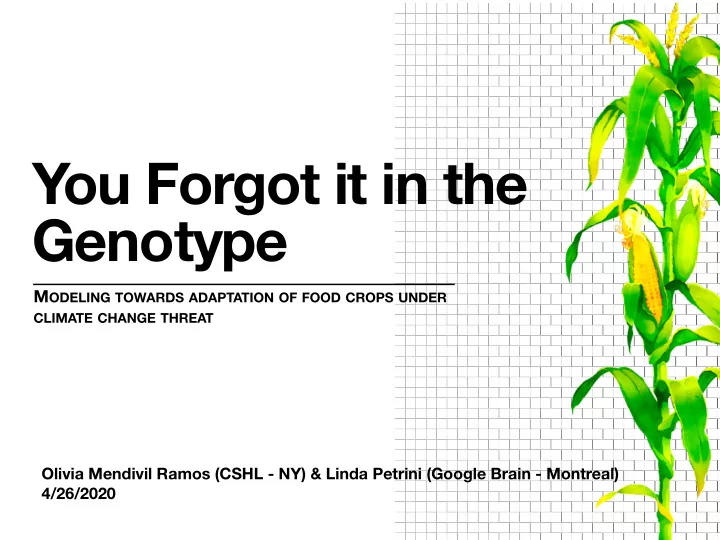

You Forgot it in the Genotype M ODELING TOWARDS ADAPTATION OF FOOD CROPS UNDER CLIMATE CHANGE THREAT Olivia Mendivil Ramos (CSHL - NY) & Linda Petrini (Google Brain - Montreal) 4/26/2020
Why modeling in agriculture? Global warming history and rate of increasing temperature its impact in agriculture IPCC, 2018 trend of crop yield in the US Global rate of undernourshiment and e ff ects of climate change FAO, 2018 EPA, 2009
State-of-the-Art models of crop yield prediction in food-crop plants as a start Perceptron model on grain yield prediction - Khaki & Wang 2019 CNN-LSTM hybrid model on grain yield prediction - Sun et al. 2019 3 common components: Genotype Weather Soil RNN model on grain yield prediction - Khaki et al. 2020
Preprocessing of the biological signal (Genotype) in these models: • Imputation based on non-biological rationale • Retain 3% of this data Phenotypic plasticity and genotype: • A recent study on genotype-by- environment variation in maize cultivars showed the artificial selection on maize, constitute a loss of the genotypic variability of the plant at the expense of high productivity in crop yield. • Fst biological measure computed from genotype as a proxy of stable and non- stable cultivars
Proposal Based on Fst measures, we split the data: • stable • non-stable Time-series dataset: Deployed on models: • 2014-2019 • Perceptron • 3 components: Raw Genotype, • CNN-LSTM hybrid Soil Management and Weather data • RNN • 1577 hybrid of Maize cultivars • 77 environments Performance measurements: • 94000 field plots (12 states in the US and Ontario in Canada) • MSE • MAE
“We aim to contribute with this modeling to the adaptation of agriculture and precision agriculture powered by genomics and leveraged by deep learning”
Questions? Olivia Mendivil Ramos (CSHL - NY) & Linda Petrini (Google Brain - Montreal) 4/26/2020
Recommend
More recommend